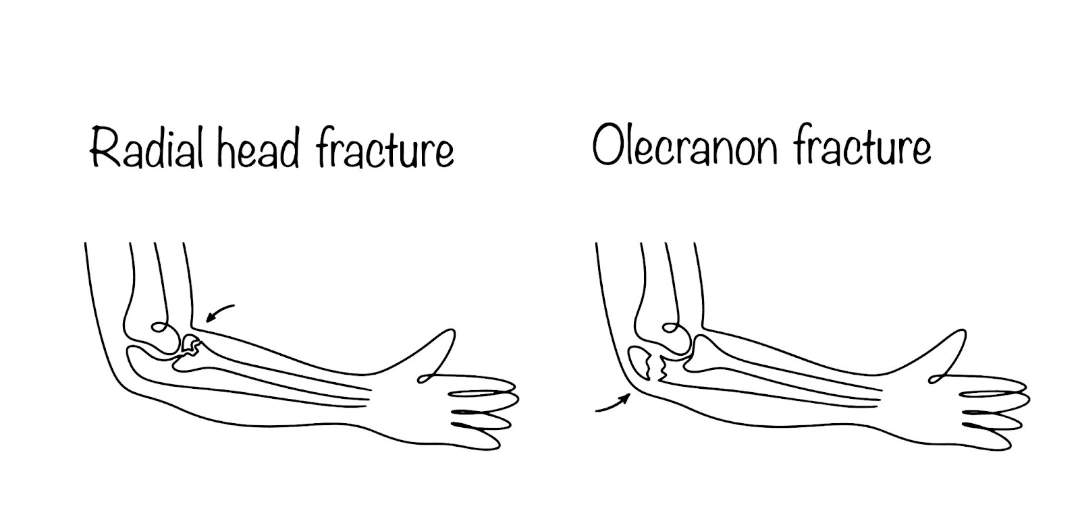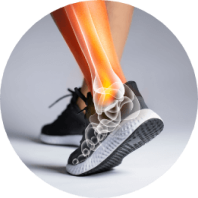Elbow
Fracture
- Home
- Conditions We Treat
- Elbow
- Elbow Fracture
What is an elbow fracture?
An elbow fracture refers to a break in one or more of the bones that form the elbow joint — the humerus (upper arm bone), radius, or ulna (forearm bones). Because the elbow is a complex hinge joint that allows both bending and rotation of the forearm, a fracture can significantly affect arm movement and daily function.
These injuries often occur in two main groups of patients: younger individuals, who typically sustain fractures from high-impact trauma such as road traffic accidents or sports injuries and older adults, who are more vulnerable to fractures from falls due to reduced bone strength. The severity of an elbow fracture can range from a small crack in the bone to complex breaks involving multiple fragments and displacement, sometimes affecting nearby ligaments, tendons, and nerves.

Prompt diagnosis and treatment are crucial, as untreated or poorly managed elbow fractures can lead to stiffness, long-term pain, instability and even arthritis in the joint.
Types of Elbow Fractures
Elbow fractures can occur in different parts of the joint, each with its own features, causes and treatment considerations. The most common types include:
- Radial head and neck fractures — these involve the top of the radius, the forearm bone on the thumb side. They often occur when a person falls on an outstretched hand, with the force transmitted up into the elbow. Patients usually experience pain when trying to rotate the forearm or straighten the elbow.
- Olecranon fractures — the olecranon is the bony tip of the ulna that forms the pointed part of the elbow. Fractures here usually result from a direct impact, such as falling directly onto the elbow. Because the triceps muscle attaches to the olecranon, these fractures often disrupt the ability to straighten the arm.
- Distal humerus fractures — these occur at the lower end of the humerus, just above the elbow joint. They are less common but can be severe, particularly in adults. Such fractures often result from high-energy trauma and may extend into the joint, requiring surgical repair to restore alignment and joint function.
- Combined or complex fractures — in some cases, more than one of the elbow bones may be fractured at the same time. These injuries are typically the result of major trauma and may be associated with dislocations or damage to surrounding soft tissues, nerves, and blood vessels.

What causes an elbow fracture?
Elbow fractures are usually the result of trauma, where a force strong enough to break bone is applied directly or indirectly to the joint. The most common causes include:
- Falls — a frequent cause, especially in older adults. Falling onto an outstretched hand transmits force through the forearm into the elbow, often resulting in a radial head fracture. Direct falls onto the elbow can also cause olecranon fractures.
- Direct impact — a strong blow to the elbow, such as from a collision, heavy object, or during contact sports, can lead to fractures.
- High-energy trauma — road traffic accidents, industrial injuries, or sports accidents involving significant force may cause more complex fractures, often affecting multiple bones or the joint surface.
- Twisting injuries — though less common, a sudden and forceful twist of the forearm or elbow can contribute to certain fracture patterns, particularly if bone strength is already reduced.
What are the signs and symptoms of an elbow fracture?

An elbow fracture usually causes immediate pain and difficulty moving the arm. The specific signs and symptoms can vary depending on the type and severity of the fracture, but commonly include:
- Severe pain around the elbow, especially when trying to bend, straighten, or rotate the arm.
- Swelling and bruising that may develop quickly after the injury.
- Visible deformity if the bones are displaced, giving the elbow an abnormal shape.
- Loss of function, with an inability to fully move the elbow or forearm.
- Tenderness to touch over the affected area.
- Numbness or weakness in the hand or fingers, which may suggest injury to nearby nerves.
- A feeling of instability in the joint, particularly in complex or associated dislocation injuries.
Because elbow fractures can sometimes be mistaken for a severe sprain or bruise, prompt medical assessment and X-rays are essential to confirm the diagnosis.
Who is at risk of an elbow fracture in Singapore?
Although an elbow fracture can occur in anyone following trauma, certain groups of people are more vulnerable due to age, bone health, or lifestyle factors.
- Older adults — ageing leads to reduced bone density and increased risk of osteoporosis. Even a minor fall can cause a fracture in elderly individuals.
- Children and adolescents — because their bones are still developing, children are prone to elbow fractures, particularly around the growth plates, when falling during play or sports.
- Athletes — sports that involve high speeds, physical contact, or the risk of falling, such as football, rugby, cycling and skating, increase the likelihood of elbow injuries.
- Manual workers — occupations that involve climbing, heavy lifting, or working at heights may expose individuals to a higher risk of falls or direct trauma.
- People with bone-weakening conditions — conditions such as osteoporosis, long-term steroid use, or certain metabolic disorders can make bones more fragile and prone to fractures.
Recognising these risk groups is important for both prevention and timely medical attention in the event of an injury.
How is an elbow fracture diagnosed?
Elbow fractures are diagnosed using a combination of clinical examination and imaging tests. These help doctors assess the extent of the injury and plan the most appropriate treatment.
- Physical examination — your doctor will carefully examine the elbow for signs of swelling, bruising, tenderness, or deformity. They may gently test movement of the arm to check for pain, stiffness, or instability, while also assessing circulation and nerve function in the hand and fingers.
- X-ray imaging — standard X-rays are the primary investigation method for suspected fractures. They reveal the location, type and severity of the break, and help determine whether the bones are displaced or involve the joint surface.
- Computed tomography (CT) scans — a CT scan may be used when an X-ray does not provide enough detail, especially for small or complex fractures. CT imaging gives a three-dimensional view of the bone and is often used to assist in planning surgical treatment.
- Magnetic resonance imaging (MRI) scans — although not typically required to confirm a fracture, MRI scans are useful in assessing associated injuries to soft tissues such as ligaments, tendons, or cartilage.
Together, these diagnostic methods ensure that even subtle fractures are detected and that all aspects of the injury are evaluated before treatment begins.
What are the complications of elbow fractures?
Although many elbow fractures heal well with proper treatment, complications can occur, particularly if the injury is severe or not managed promptly. Some of the more common complications include:
- Joint stiffness — stiffness is one of the most frequent problems following an elbow fracture. Even with appropriate treatment, the elbow may not regain its full range of motion. Early rehabilitation helps reduce this risk.
- Post-traumatic arthritis — damage to the cartilage or irregular healing of the joint surface can lead to arthritis over time, causing pain, swelling and reduced movement.
- Nerve injury — the ulnar, median, or radial nerves run close to the elbow and may be injured at the time of the fracture or during surgery. This can result in numbness, tingling, or weakness in the hand or fingers.
- Blood vessel injury — fractures, particularly of the distal humerus, may injure nearby blood vessels, potentially compromising blood flow to the forearm and hand.
- Malunion or non-union — in some cases, the bones may heal in an incorrect position (malunion) or fail to heal properly (non-union), leading to deformity, instability, or long-term pain.
- Heterotopic ossification — abnormal bone formation within soft tissues around the elbow can occur during recovery, further restricting movement.
- Infection — this is a risk after surgical treatment, particularly in open fractures or where metal implants are used.
These complications highlight the importance of early diagnosis, appropriate treatment, and structured rehabilitation to optimise recovery.
What are the treatment options for an elbow fracture?
Treatment of elbow fractures depends on the severity, location and stability of the fracture. Broadly, they may be managed with either non-operative or operative methods.
Non-operative treatment
Non-operative care is generally reserved for minor, non-displaced fractures that are stable and expected to heal without surgical intervention.
- Immobilisation — a splint or cast may be applied for a short period, typically one to two weeks, to allow initial healing. Prolonged immobilisation is avoided to reduce the risk of stiffness. Once the fracture is stable enough, the doctor may recommend gentle range-of-motion exercises.
- Rehabilitation — rehabilitation is essential after immobilisation, as stiffness, weakness, or heterotopic ossification (abnormal bone formation in soft tissue) may develop during recovery. Physiotherapy aims to restore joint mobility, strength and function of the arm.
2. Operative treatment
Surgery is usually required for displaced, unstable, or complex fractures where bone fragments need to be realigned and stabilised for proper healing. Common surgical techniques include:
- Open reduction and internal fixation (ORIF) — this involves surgically exposing the fracture site to realign the bones, followed by fixation with plates, screws, or wires. It is one of the most common procedures for displaced fractures.
- Closed reduction with percutaneous pinning — a minimally invasive method where pins are inserted through the skin to hold bone fragments together. It is often used for certain humeral fractures.
- Intramedullary nailing (IMN) — a metal rod is inserted into the marrow canal of the bone and stabilised with screws or pins. Though more common in long bone fractures, IMN may also be used for specific olecranon fractures.
- Plate or screw fixation — metal plates and screws are attached to the bone to stabilise multiple fragments, particularly in comminuted fractures (where the bone breaks into several pieces).
- Tension band wiring — a wire loop is used to stabilise fractures, particularly of the olecranon, by converting muscle pull into compressive forces that promote bone healing.
- Fragment excision — small loose bone fragments may be removed if reconstruction is not possible. This technique is typically reserved for elderly or low-demand patients, as it may reduce joint stability.
- Elbow arthroplasty — in cases where the joint surface is severely damaged, part or all of the elbow may be replaced with a prosthesis. Radial head arthroplasty is commonly performed for irreparable radial head fractures.
The choice of treatment depends on factors such as patient age, activity level, fracture type, and presence of associated injuries. Both surgical and non-surgical approaches are followed by rehabilitation to achieve the best possible outcome.
Recovery and prognosis of elbow fractures
Recovering from an elbow fracture can be a lengthy process and outcomes depend on both the severity of the injury and the commitment to rehabilitation. With timely treatment and proper follow-up, most patients are able to regain good function in their arm and return to daily activities.
- Healing time — most elbow fractures take about six to eight weeks for the bone to heal, though full recovery of movement and strength can take several months.
- Non-surgical recovery — simple, non-displaced fractures treated without surgery often heal well. Early supervised exercises usually lead to good restoration of elbow function.
- Post-surgical recovery — complex fractures requiring surgery generally involve a longer healing process and more intensive rehabilitation, especially if the joint surface is affected.
- Rehabilitation — physiotherapy is crucial to reduce stiffness and regain movement. Patients are encouraged to start gentle range-of-motion exercises as soon as it is safe.
- Long-term outlook — most patients recover well, but some may experience residual stiffness, weakness, or discomfort. Severe fractures carry a higher risk of post-traumatic arthritis or chronic pain.
Summary
Elbow fractures are common injuries that can affect people of all ages, often resulting from falls, direct impacts, or high-energy trauma. They may involve the radial head, olecranon, or distal humerus, with symptoms such as pain, swelling, bruising and loss of movement.
Treatment depends on the severity of the fracture. Stable, non-displaced fractures may be managed with short-term immobilisation and physiotherapy, while displaced or complex injuries often require surgical procedures such as fixation with plates, screws, or wires, or in some cases joint replacement. With timely treatment and structured follow-up, most patients regain good function, though severe fractures may carry risks such as arthritis, nerve injury, or long-term stiffness.
If you are experiencing elbow pain after an injury, or suspect a fracture, schedule a consultation with us for specialist assessment, accurate diagnosis and tailored treatment to restore the health and function of your elbow.
Conditions We Treat





Frequently asked questions
Can I move my arm after an elbow fracture?
Movement is usually very painful at first and should be avoided until a doctor confirms it is safe. Controlled exercises will be introduced later as part of recovery.
Will an elbow fracture show up immediately on an X-ray?
Most fractures are visible straight away, but very small cracks or fractures hidden by swelling may require repeat imaging or a CT scan for confirmation.
Do elbow fractures always need a plaster cast?
Not always. Some minor, stable fractures may only require a sling for support, while surgical cases use plates, screws, or wires instead of a cast.
How long will I need to wear a sling or cast after an elbow fracture?
Immobilisation usually lasts one to three weeks for simple fractures, but the exact duration depends on the severity and type of injury.
When can I drive after an elbow fracture?
Driving is usually not safe until you can comfortably perform an emergency stop and have adequate strength in your arm, which may take several weeks. Always check with your doctor before resuming driving.
Can I return to sports after an elbow fracture?
Yes, but only after full healing and advice from your doctor. Returning too early increases the risk of re-injury or long-term stiffness.
Are children treated differently for elbow fractures?
Yes. Children often heal faster, but fractures near the growth plate require close monitoring to prevent long-term growth or alignment problems.
Can an elbow fracture affect nerves permanently?
In most cases, nerve symptoms improve with healing, but severe injuries can occasionally cause long-term weakness or numbness in the hand or fingers.
What happens if an elbow fracture is left untreated?
Without treatment, an elbow fracture can lead to deformity, chronic pain, stiffness, arthritis, or permanent loss of function in the arm.
Is swelling normal after an elbow fracture?
Yes, swelling is common and usually subsides with rest, ice, elevation and treatment. Persistent or worsening swelling should be checked by a doctor.



